Sorting Materials Into Groups
Anything that can be seen and touched is called an object. We see a large number of objects around us. For example, a chair, a bullock cart, a cycle, cooking utensils, books, clothes, toys, water, stones, vegetables, plants, animals, etc.
All these objects have different shapes, colours and uses. The matter of which an object is made is called material. All objects are made up of one or more materials. For example, the chair and table are made up of wood here, wood is a material.
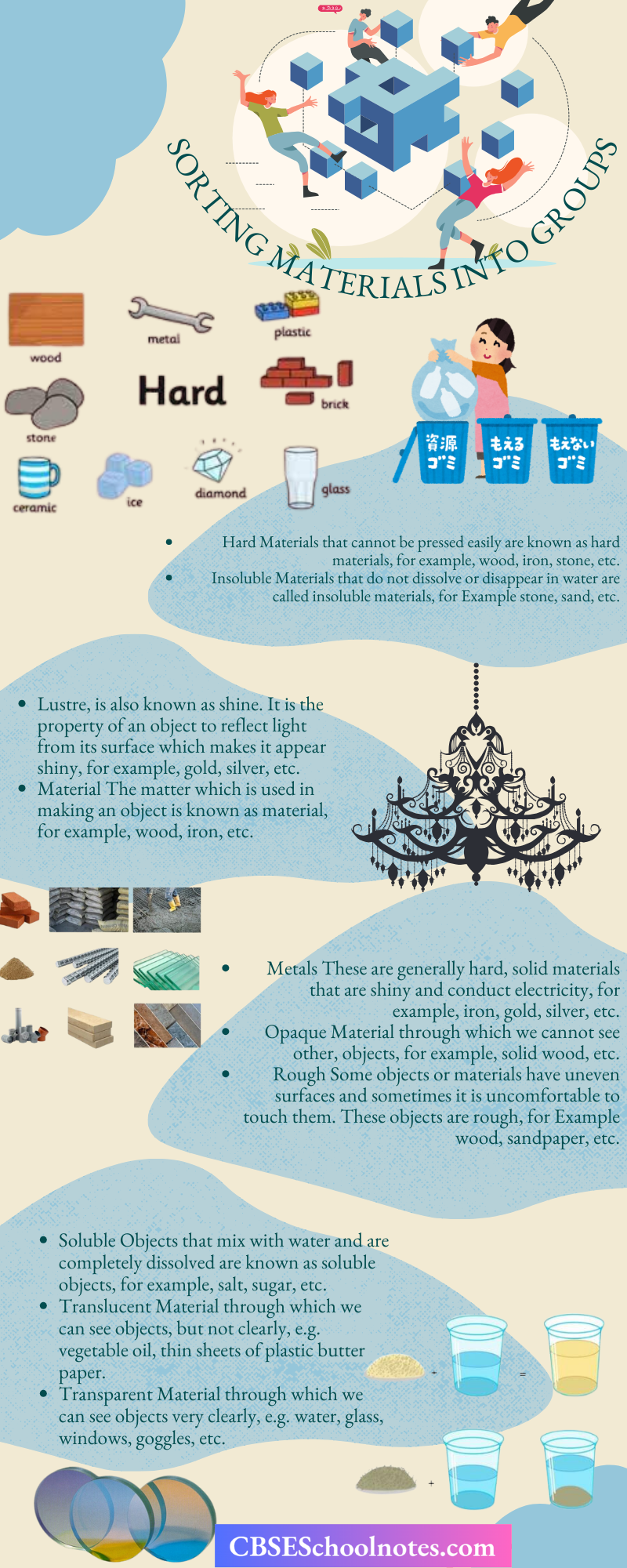
Grouping Of Objects
Objects can be grouped according to the materials they are made up of.
- The same object can be made up of different materials, Example plates can be made up of steel, glass, and plastics similarly, toys can be made up of plastics, rubber, metal, etc.
- Different objects can be made up of the same material, Example wood, which can be used to make chairs, tables, beds, ploughs, etc. Similarly, leather can be used to make belts, wallets, purses, bags, etc.
We can also separate materials into several groups based on similarities or differences in their properties.
Read and Learn More Class 6 Science Notes
Properties Of Materials
Different materials have different properties. Material to make an object is chosen depending on its properties and the purpose for which the object is to be used.
For example, we make a tumbler from materials such as glass, plastic or steel because all these materials have the property of storing water or other liquids. We cannot make a tumbler from a piece of cloth because it cannot hold water.
Similarly, it would not be a wise idea to use paper-like materials for cooking vessels. Some of the properties of materials based on which they can be chosen for different purposes are explained below.
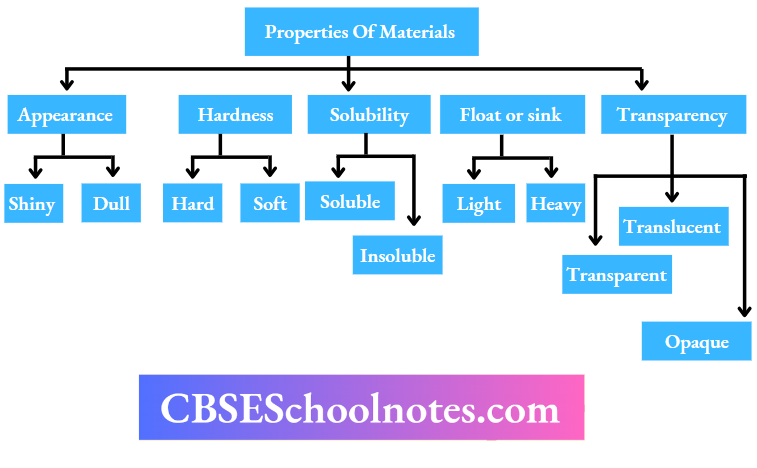
Appearance
Some materials may appear shiny, while some might seem dull. For example, gold, silver, aluminium, and iron shine, while wood, plastic, paper, and rubber are dull.
Materials which appear shiny are said to have lustre (or in Hindi chamak). These materials often lose their shine due to the action of air and moisture. Flowevcr, their shine reappears after rubbing or cutting the surface. That’s why lustre is often noticed on freshly cut ends.
Dull materials remain the same even after rubbing or cutting them. Some materials differ in colour, glow and texture of their surfaces as well, (i.e. rough or smooth) and can be grouped accordingly.
Hardness and Softness
- Those materials which cannot be compressed or scratched easily are called hard materials. For example, iron, steel, wood, stone, etc.
- Those materials which can be easily compressed or scratched are called soft materials. For example, cotton, wool, clay, butter, etc.
- Science Insight Diamond is the hardest known material. It cannot be scratched by other materials and only be cut by the diamond itself.
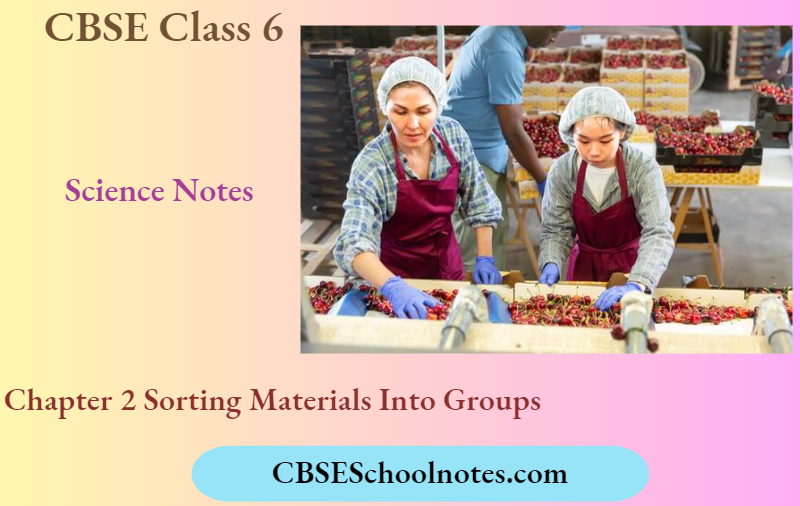
Soluble or Insoluble
Solubility is defined as the ability of a solid, liquid or gaseous substance to dissolve in a solvent (usually a liquid). Based on solubility in water, the material can be soluble or insoluble. Those materials which are completely dissolved or disappear in water are called soluble materials.
Those materials which are not dissolved or disappear in water even after stirring for a long time are called insoluble materials.
Water plays an important role in the functioning ofour body because it can dissolve a large number of substances. Solubility of Solids in Water Some solids completely dissolve or disappear in water, for example, salt, sugar, etc.
Some solids do not dissolve or disappear in water, for example, sand, dust, chalk powder, plastic, etc. They settle down or float on water.
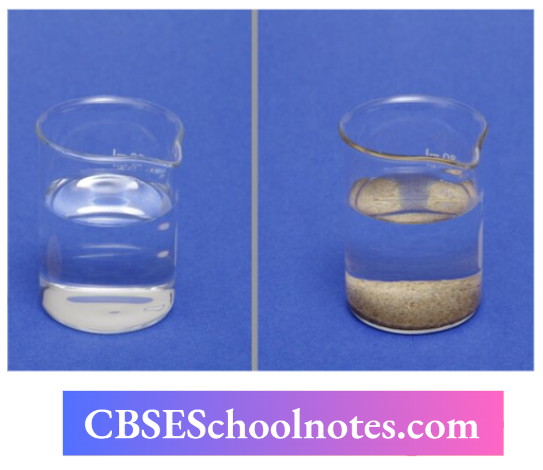
Solubility of Liquid in Water
Some liquids get completely mixed or dissolve in water, for example, vinegar, etc. On the other hand, some liquids do not mix with water and form a separate layer when kept aside for some time, for example, mustard oil, coconut oil, etc.
Solubility of Gases in Water
Some gases are soluble in water while others are not. For example, oxygen gas dissolves in water and is very important for the survival of animals and plants that live in water.Carbon dioxide gas also dissolves in water and helps in photosynthesis in underwater plants. Some gases like nitrogen and hydrogen are not dissolved in water.
Objects may Float or Sink in Water
Some materials that are not mixed or dissolved in water either float on the surface of the water or sink to the bottom of the tumbler.
The property of a material to float on the surface of the water is called flotation and these materials are called floating materials, Example dried leaves fall on the surface of a pond. These materials are lighter than water.
The heavy materials that sink easily to the bottom of the tumbler are called sinking materials, for Example stones thrown into the pond, drops of honey in water, etc. These materials are heavier than water.

Science Insight Ships and boats float higher in the salty sea water than they do in the freshwater of lakes and rivers. This is because salt in seawater makes it denser than freshwater.
Transparency
The property of a material which allows the light to pass through it is called transparency. Based on this property, materials can be classified as follows
1. Transparent Materials
The materials through which an object can be seen are called transparent materials, for example, glass, water, some plastics, etc.
2. Translucent Materials
The materials through which an object can be seen, but not clearly, are called translucent materials, for example, oiled paper, muslin cloth, frosted window, etc.
3. Opaque Materials
The materials through which we are not able to see anything are called opaque materials, for example, wood, cardboard, brick, metal, etc.

Importance Of Sorting Materials Into Groups
In everyday life we often group materials for our convenience as grouping of materials helps us to locate them easily.
For example, in the library, books are arranged in alphabetical order. In grocery stores, household items and eatables items are placed separately. The grouping of materials makes it convenient to study their properties.
Activity 1
Aim: To separate the shiny materials from paper, cardboard wood, copper wire, aluminium sheet, and chalk.
Materials Required: Paper, cardboard, wood, copper wire, aluminium sheet, chalk.
Procedure:
- Collect some small pieces of given materials.
- Observe the shine in all materials.
- You can rub the surface of materials or cut to see if it
has lustre or not. - Separate the shiny materials.
- Note your observations in the table given below.
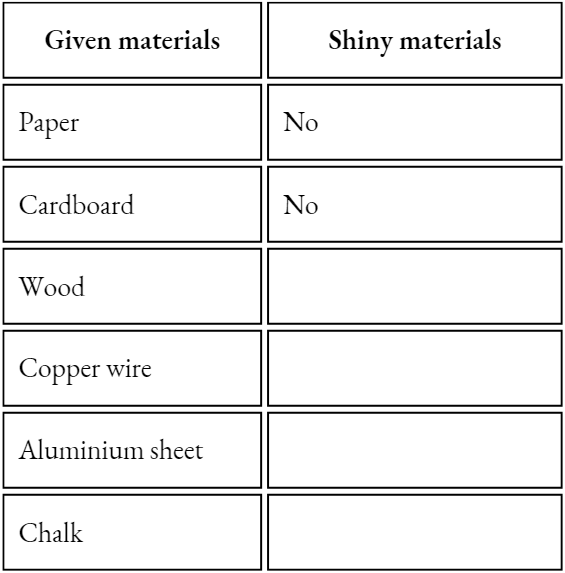
Observation:
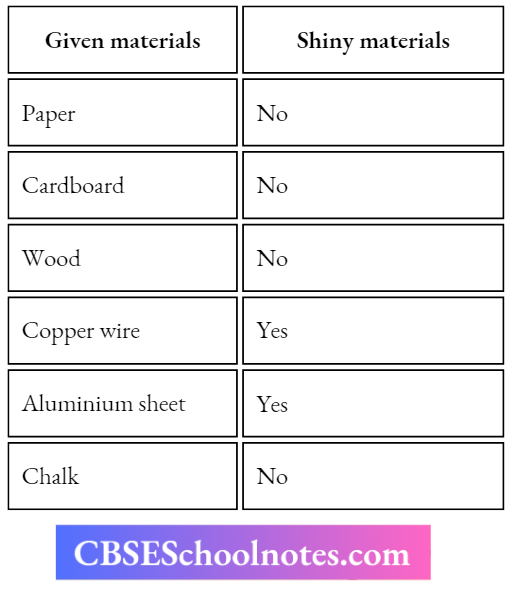
Conclusion: Some of the given materials like copper wire aluminium sheets, have a shiny appearance while others have a dull appearance. The materials with shiny appearance are said to have lustre.
Activity 2
Aim: To observe whether different solid materials (like sugar, salt, chalk powder, sand, and sawdust) are soluble or insoluble in water.
Materials Required: Beakers, spoon, water and solid materials like sugar, salt, chalk powder, sand, and sawdust.
Procedure:
- Collect samples of some solid materials.
- Take five beakers. Fill each of them up to two-thirds volume with water.
- Add a small amount of each given material, in different beakers separately.
- Stir the contents of each beaker with the help of a spoon.
- Note your observations in the table given below

Observation
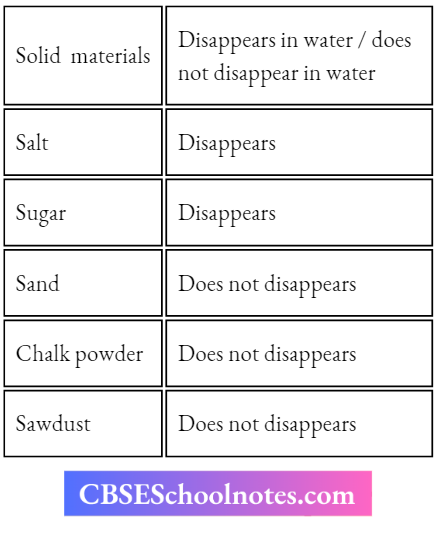
Conclusion: You will notice that some solid materials have completely disappeared and thus, are soluble in water. Whereas other solid materials like sand, chalk powder, and sawdust do not disappear and are thus, insoluble in water.
Activity 3
Aim: To observe whether liquid samples, like lemon juice, vinegar, mustard oil, coconut oil, and kerosene are soluble or insoluble in water.
Materials Required: Glass tumbler, water, a sample of vinegar, lemon juice, mustard oil, coconut oil, and kerosene.
Procedure:
- Collect given samples of liquids like lemon juice, vinegar, etc.
- Take a glass tumbler. Fill it half with water.
- Add a spoonful of one liquid to this and stir it well,
- Let it stand for five minutes.
- Observe whether the liquid mixes with water.
- Repeat the same procedure with other given liquids also.
- Write observations in the table given below.
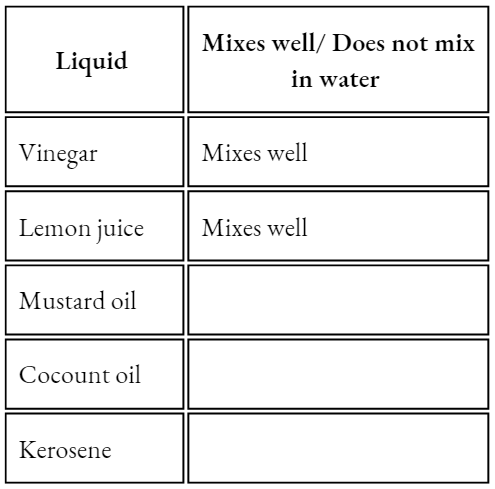
Observation:
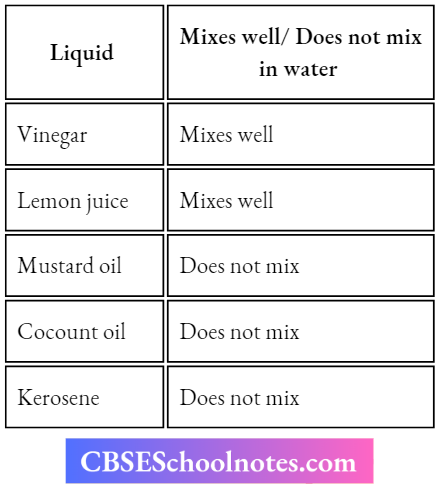
Conclusion: We notice that some liquids like vinegar, and lemon juice get completely mixed with water.
So, these are soluble in water while liquids like mustard oil, coconut oil, and kerosene do not get mixed with water and form a separate layer when kept for some time. So, these are insoluble in water.
Activity 4
Aim: To differentiate between translucent and opaque materials.
Materials Required: Electric bulb, sheet of paper, oil, torch.
Procedure:
- Take a sheet of paper.
- Look through it towards a lighted bulb.
- Make a note of your observations.
- Now, put 2-3 drops of some oil and spread it on a sheet of paper.
- Look again towards the lighted bulb through it.
- Note your observations again.
- Now, take a torch and cover the glass of the torch with your palm in a dark place.
- Switch on the torch and observe the other side of your palm.
Observation:
- When we look at the lighted bulb through the paper, we do not see any light.
- When we spread some oil on the paper and look at the lighted bulb through it, we see some light, but not as clearly.
- When we cover the glass of the torch with our palm and switch on the torch, we see a small amount of light on the other side of the palm.
Conclusion: We find that materials, in which an object can be seen, but not clearly are called translucent.
Materials which does not allow any light to pass through are called opaque. Hence, in the above observation, paper is an opaque material while paper spread with oil and palm is translucent.
